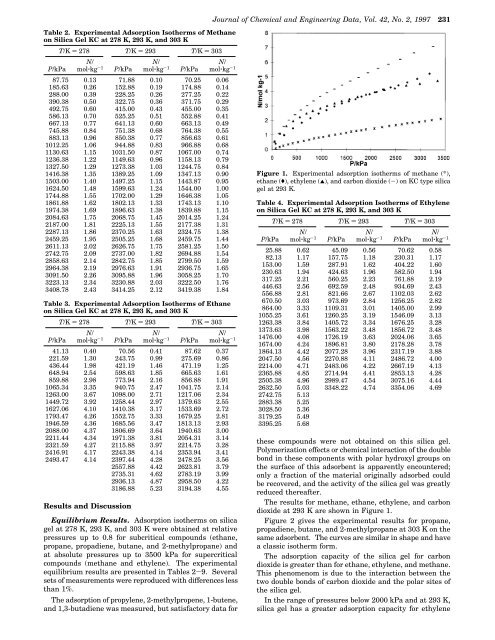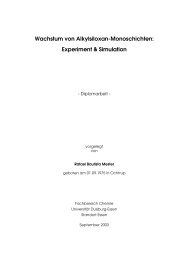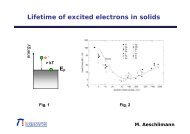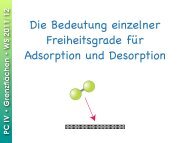Adsorption of Light Hydrocarbons and Carbon Dioxide on Silica Gel
Adsorption of Light Hydrocarbons and Carbon Dioxide on Silica Gel
Adsorption of Light Hydrocarbons and Carbon Dioxide on Silica Gel
Create successful ePaper yourself
Turn your PDF publications into a flip-book with our unique Google optimized e-Paper software.
Journal <str<strong>on</strong>g>of</str<strong>on</strong>g> Chemical <str<strong>on</strong>g>and</str<strong>on</strong>g> Engineering Data, Vol. 42, No. 2, 1997 231<br />
Table 2. Experimental <str<strong>on</strong>g>Adsorpti<strong>on</strong></str<strong>on</strong>g> Isotherms <str<strong>on</strong>g>of</str<strong>on</strong>g> Methane<br />
<strong>on</strong> <strong>Silica</strong> <strong>Gel</strong> KC at 278 K, 293 K, <str<strong>on</strong>g>and</str<strong>on</strong>g> 303 K<br />
P/kPa<br />
T/K ) 278 T/K ) 293 T/K ) 303<br />
N/<br />
mol‚kg -1<br />
P/kPa<br />
Results <str<strong>on</strong>g>and</str<strong>on</strong>g> Discussi<strong>on</strong><br />
N/<br />
mol‚kg -1<br />
P/kPa<br />
N/<br />
mol‚kg -1<br />
87.75 0.13 71.88 0.10 70.25 0.06<br />
185.63 0.26 152.88 0.19 174.88 0.14<br />
288.00 0.39 228.25 0.26 277.25 0.22<br />
390.38 0.50 322.75 0.36 371.75 0.29<br />
492.75 0.60 415.00 0.43 455.00 0.35<br />
586.13 0.70 525.25 0.51 552.88 0.41<br />
667.13 0.77 641.13 0.60 663.13 0.49<br />
745.88 0.84 751.38 0.68 764.38 0.55<br />
883.13 0.96 850.38 0.77 856.63 0.61<br />
1012.25 1.06 944.88 0.83 966.88 0.68<br />
1130.63 1.15 1031.50 0.87 1067.00 0.74<br />
1236.38 1.22 1149.63 0.96 1158.13 0.79<br />
1327.50 1.29 1273.38 1.03 1244.75 0.84<br />
1416.38 1.35 1389.25 1.09 1347.13 0.90<br />
1503.00 1.40 1497.25 1.15 1443.87 0.95<br />
1624.50 1.48 1599.63 1.24 1544.00 1.00<br />
1744.88 1.55 1702.00 1.29 1646.38 1.05<br />
1861.88 1.62 1802.13 1.33 1743.13 1.10<br />
1974.38 1.69 1896.63 1.38 1839.88 1.15<br />
2084.63 1.75 2068.75 1.45 2014.25 1.24<br />
2187.00 1.81 2225.13 1.55 2177.38 1.31<br />
2287.13 1.86 2370.25 1.63 2324.75 1.38<br />
2459.25 1.95 2505.25 1.68 2459.75 1.44<br />
2611.13 2.02 2626.75 1.75 2581.25 1.50<br />
2742.75 2.09 2737.00 1.82 2694.88 1.54<br />
2858.63 2.14 2842.75 1.85 2799.50 1.59<br />
2964.38 2.19 2976.63 1.91 2936.75 1.65<br />
3091.50 2.26 3095.88 1.96 3058.25 1.70<br />
3223.13 2.34 3230.88 2.03 3222.50 1.76<br />
3408.78 2.43 3414.25 2.12 3419.38 1.84<br />
Table 3. Experimental <str<strong>on</strong>g>Adsorpti<strong>on</strong></str<strong>on</strong>g> Isotherms <str<strong>on</strong>g>of</str<strong>on</strong>g> Ethane<br />
<strong>on</strong> <strong>Silica</strong> <strong>Gel</strong> KC at 278 K, 293 K, <str<strong>on</strong>g>and</str<strong>on</strong>g> 303 K<br />
P/kPa<br />
T/K ) 278 T/K ) 293 T/K ) 303<br />
N/<br />
mol‚kg -1<br />
P/kPa<br />
N/<br />
mol‚kg -1<br />
P/kPa<br />
N/<br />
mol‚kg -1<br />
41.13 0.40 70.56 0.41 87.62 0.37<br />
221.59 1.30 243.75 0.99 275.69 0.86<br />
436.44 1.98 421.19 1.46 471.19 1.25<br />
648.94 2.54 598.63 1.85 665.63 1.61<br />
859.88 2.98 773.94 2.16 856.88 1.91<br />
1065.34 3.35 940.75 2.47 1041.75 2.14<br />
1263.00 3.67 1098.00 2.71 1217.06 2.34<br />
1449.72 3.92 1258.44 2.97 1379.63 2.55<br />
1627.06 4.10 1410.38 3.17 1533.69 2.72<br />
1793.47 4.26 1552.75 3.33 1679.25 2.81<br />
1946.59 4.36 1685.56 3.47 1813.13 2.93<br />
2088.00 4.37 1806.69 3.64 1940.63 3.00<br />
2211.44 4.34 1971.38 3.81 2054.31 3.14<br />
2321.59 4.27 2115.88 3.97 2214.75 3.28<br />
2416.91 4.17 2243.38 4.14 2353.94 3.41<br />
2493.47 4.14 2397.44 4.28 2478.25 3.56<br />
2557.88 4.42 2623.81 3.79<br />
2735.31 4.62 2783.19 3.99<br />
2936.13 4.87 2958.50 4.22<br />
3186.88 5.23 3194.38 4.55<br />
Equilibrium Results. <str<strong>on</strong>g>Adsorpti<strong>on</strong></str<strong>on</strong>g> isotherms <strong>on</strong> silica<br />
gel at 278 K, 293 K, <str<strong>on</strong>g>and</str<strong>on</strong>g> 303 K were obtained at relative<br />
pressures up to 0.8 for subcritical compounds (ethane,<br />
propane, propadiene, butane, <str<strong>on</strong>g>and</str<strong>on</strong>g> 2-methylpropane) <str<strong>on</strong>g>and</str<strong>on</strong>g><br />
at absolute pressures up to 3500 kPa for supercritical<br />
compounds (methane <str<strong>on</strong>g>and</str<strong>on</strong>g> ethylene). The experimental<br />
equilibrium results are presented in Tables 2-9. Several<br />
sets <str<strong>on</strong>g>of</str<strong>on</strong>g> measurements were reproduced with differences less<br />
than 1%.<br />
The adsorpti<strong>on</strong> <str<strong>on</strong>g>of</str<strong>on</strong>g> propylene, 2-methylpropene, 1-butene,<br />
<str<strong>on</strong>g>and</str<strong>on</strong>g> 1,3-butadiene was measured, but satisfactory data for<br />
Figure 1. Experimental adsorpti<strong>on</strong> isotherms <str<strong>on</strong>g>of</str<strong>on</strong>g> methane (*),<br />
ethane ((), ethylene (2), <str<strong>on</strong>g>and</str<strong>on</strong>g> carb<strong>on</strong> dioxide (-) <strong>on</strong> KC type silica<br />
gel at 293 K.<br />
Table 4. Experimental <str<strong>on</strong>g>Adsorpti<strong>on</strong></str<strong>on</strong>g> Isotherms <str<strong>on</strong>g>of</str<strong>on</strong>g> Ethylene<br />
<strong>on</strong> <strong>Silica</strong> <strong>Gel</strong> KC at 278 K, 293 K, <str<strong>on</strong>g>and</str<strong>on</strong>g> 303 K<br />
P/kPa<br />
T/K ) 278 T/K ) 293 T/K ) 303<br />
N/<br />
mol‚kg -1<br />
P/kPa<br />
N/<br />
mol‚kg -1<br />
P/kPa<br />
N/<br />
mol‚kg -1<br />
25.88 0.62 45.09 0.56 70.62 0.58<br />
82.13 1.17 157.75 1.18 230.31 1.17<br />
153.00 1.59 287.91 1.62 404.22 1.60<br />
230.63 1.94 424.63 1.96 582.50 1.94<br />
317.25 2.21 560.25 2.23 761.88 2.19<br />
446.63 2.56 692.59 2.48 934.69 2.43<br />
556.88 2.81 821.66 2.67 1102.03 2.62<br />
670.50 3.03 973.69 2.84 1256.25 2.82<br />
864.00 3.33 1109.31 3.01 1405.00 2.99<br />
1055.25 3.61 1260.25 3.19 1546.09 3.13<br />
1263.38 3.84 1405.72 3.34 1676.25 3.28<br />
1373.63 3.98 1563.22 3.48 1856.72 3.48<br />
1476.00 4.08 1726.19 3.63 2024.06 3.65<br />
1674.00 4.24 1896.81 3.80 2178.28 3.78<br />
1864.13 4.42 2077.28 3.96 2317.19 3.88<br />
2047.50 4.56 2270.88 4.11 2486.72 4.00<br />
2214.00 4.71 2483.06 4.22 2667.19 4.13<br />
2365.88 4.85 2714.94 4.41 2853.13 4.28<br />
2505.38 4.96 2989.47 4.54 3075.16 4.44<br />
2632.50 5.03 3348.22 4.74 3354.06 4.69<br />
2742.75 5.13<br />
2883.38 5.25<br />
3028.50 5.36<br />
3179.25 5.49<br />
3395.25 5.68<br />
these compounds were not obtained <strong>on</strong> this silica gel.<br />
Polymerizati<strong>on</strong> effects or chemical interacti<strong>on</strong> <str<strong>on</strong>g>of</str<strong>on</strong>g> the double<br />
b<strong>on</strong>d in these comp<strong>on</strong>ents with polar hydroxyl groups <strong>on</strong><br />
the surface <str<strong>on</strong>g>of</str<strong>on</strong>g> this adsorbent is apparently encountered;<br />
<strong>on</strong>ly a fracti<strong>on</strong> <str<strong>on</strong>g>of</str<strong>on</strong>g> the material originally adsorbed could<br />
be recovered, <str<strong>on</strong>g>and</str<strong>on</strong>g> the activity <str<strong>on</strong>g>of</str<strong>on</strong>g> the silica gel was greatly<br />
reduced thereafter.<br />
The results for methane, ethane, ethylene, <str<strong>on</strong>g>and</str<strong>on</strong>g> carb<strong>on</strong><br />
dioxide at 293 K are shown in Figure 1.<br />
Figure 2 gives the experimental results for propane,<br />
propadiene, butane, <str<strong>on</strong>g>and</str<strong>on</strong>g> 2-methylpropane at 303 K <strong>on</strong> the<br />
same adsorbent. The curves are similar in shape <str<strong>on</strong>g>and</str<strong>on</strong>g> have<br />
a classic isotherm form.<br />
The adsorpti<strong>on</strong> capacity <str<strong>on</strong>g>of</str<strong>on</strong>g> the silica gel for carb<strong>on</strong><br />
dioxide is greater than for ethane, ethylene, <str<strong>on</strong>g>and</str<strong>on</strong>g> methane.<br />
This phenomenom is due to the interacti<strong>on</strong> between the<br />
two double b<strong>on</strong>ds <str<strong>on</strong>g>of</str<strong>on</strong>g> carb<strong>on</strong> dioxide <str<strong>on</strong>g>and</str<strong>on</strong>g> the polar sites <str<strong>on</strong>g>of</str<strong>on</strong>g><br />
the silica gel.<br />
In the range <str<strong>on</strong>g>of</str<strong>on</strong>g> pressures below 2000 kPa <str<strong>on</strong>g>and</str<strong>on</strong>g> at 293 K,<br />
silica gel has a greater adsorpti<strong>on</strong> capacity for ethylene







